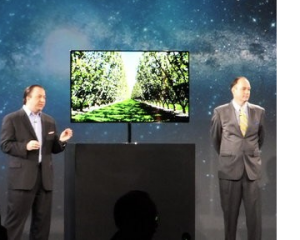The most buzzed about items at the 2012 International Consumer Electronics Show were undoubtedly OLED televisions — namely Samsung’s and LG’s — but questions remain whether the items are more than just another hyped, yet useless gadget.
There’s no denying that OLED televisions offer an incredible picture — these eyes have never seen something so clear and beautiful — but who knows whether they will ever really catch on worldwide. OLED stands for “organic light-emitting diode.”
It seems as if there is always some hot new television advancement that is hitting the market — oftentimes introduced at CES — but not all take over the market like most predicted. 3D televisions were supposed to dominate the market, yet look doubtful to ever really make a major dent into the industry, especially for homeowners.
CES 2012 still had a lot of 3D televisions and related technology, but generated significantly less interest than it did a year ago. The reason why is because people finally figured out that although the technology is pretty cool — who doesn’t love watching something in 3D? — it just isn’t that viable. Seeing Avatar in 3D in a massive movie theater is an incredible experience, but watching a similar movie in 3D on a significantly smaller screen in the confines of your home just doesn’t affect you in the same way.
OLED televisions certainly offer some amazing upgrades to your standard LED television, but excuse me if I’m a bit hesitant to anoint it as the next item to appear in all of our homes.
One of the best at CES in Las Vegas was LG’s 55-inch OLED television. LG hypes the 3D capable television as only four millimeters deep and uses technology that recreates its own light energy organically. The television was named CNET’s Best of CES 2012 — the other top contender was actually Samsung’s OLED television — and was one of the most trafficked areas at the Las Vegas Convention Center.
It hasn’t hit the markets yet nor does it have a price tag on it, though early guesses have it coming out in the second or third quarter. LG has refused to speculate on the price, but DisplaySearch estimates that it will retail for $8,000.
The high price tag would make owning the OLED extremely cost-prohibitive to most Americans. Even LG doesn’t expect a lot of people to buy at that price — it hopes to sell 30,000 units a month — but that hefty price tag won’t come down unless more people buy. The more people that buy the television, the lower the manufacturing costs become.
There’s no doubt that the most ardent of television aficionados will try to pick up an OLED television, but it could be years, if at all, for your average homeowner to be able to purchase the high-end electronic.
This isn’t an attempt to rain on the OLED television parade, but tempering expectations would be useful in this instance. It’s natural to want to hype up a cool gadget as the next item to take over our existence, but more often than not that doesn’t happen.
OLED televisions appear to be pretty fantastic televisions and I’d love to own one in my home. But don’t bet the house that they will revolutionize the way we watch television, as some have suggested.
They could certainly see widespread success at some point, but as we saw with 3D televisions, it is far from a guarantee.

